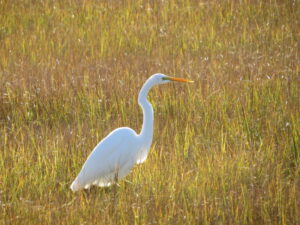(Story and photos by Pam Hunt)
Late summer typically sees an influx of wading birds into New Hampshire from breeding areas to the south. Since most of these species don’t breed locally (but see below), their movements can be particularly obvious – especially in inland areas. No species illustrates this better than the Great Egret (Ardea alba), as shown in Figure 1. Starting in July, large numbers of young egrets disperse from the colonies where they were raised, resulting in a dramatic increase in numbers along the coast. This same phenomenon occurs inland, where it starts a little later and has a much lower magnitude. No matter where you are in New Hampshire, the numbers of dispersing birds varies among years, often depending on some combination of breeding success and foraging habitat. For instance, in years of drought, egrets are more likely to wander farther in search of suitable feeding areas, and this is perhaps when they are more likely to show up in unexpected locations.

The best places to look for late summer egrets away from the coast are the Connecticut and Merrimack valleys, but they can show up anywhere – as evidenced by one flying over Dixville Peak in September 2019!
These large late summer incursions of egrets are a relatively recent phenomenon, since like so many other wading birds they were indiscriminately hunted for their plumes until the early 1900s – so much so that the entire U.S. population was estimated at 3000 in 1910. Increased protections, including of nesting sites, has allowed their populations to recover dramatically (Figure 2) and a century later experts estimate there are now 180,000.

As part of this recovery, Great Egrets gradually expanded northward along the Atlantic coast, and now breed well into Maine, as well as inland in the Great Lakes. The nearest colony to New Hampshire is on Appledore Island in the Isles of Shoals, which the species (and other herons) recolonized in the early 2000s when the human presence was much reduced due to COVID-19. Only a handful of pairs currently nest there, but the colony continues to grow.

Globally, the Great Egret is one of only a few truly “cosmopolitan” birds, meaning it nests on every continent except Antarctica. It is clearly a highly adaptable bird, possibly because it’s able to breed and forage in a wide range of habitats. This adaptability has certainly aided in its recovery, to the extent that very few significant threats have been identified. One of the greatest is disturbance at colonies, whether by predators or repeated incursions by people, and for this reason it is important to give a wading bird rookery some space from May to August. As top predators in aquatic systems, egrets may be impacted by consumption of chemical contaminants (e.g., mercury, pesticides, etc.), although there are limited data on this potential threat. Thankfully the data we do have are not terribly concerning, and most colonies are in hard-to-reach places, so the future of Great Egrets along our coast (in increasingly inland) appears secure.
State of the Birds at a Glance:
- Habitat: Salt marsh, coastal islands, marsh and shrub wetlands, lakes and rivers
- Migration: Short-to-long Distance
- Population trend: Strongly increasing
- Threats: Disturbance at nesting colonies, contaminants
- Conservation actions: Give colonies space, reduce use of potentially dangerous chemicals
